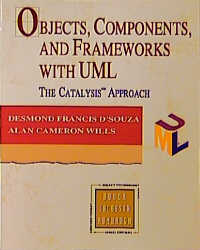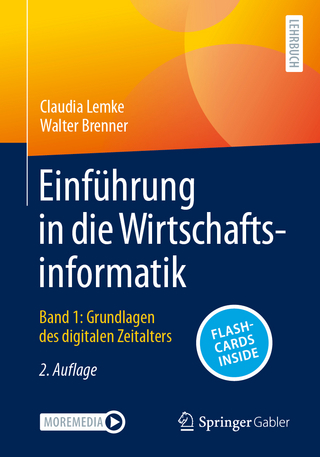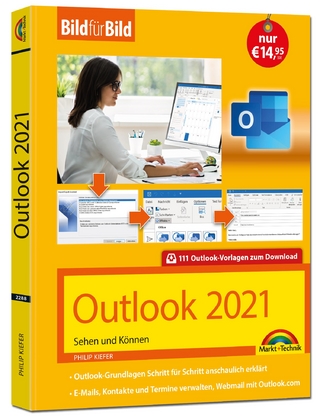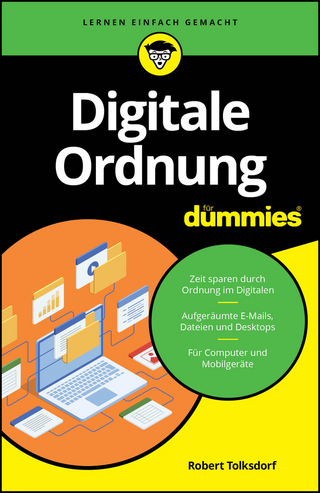
Objects, Components, and Frameworks with UML
Addison Wesley (Verlag)
978-0-201-31012-2 (ISBN)
- Titel ist leider vergriffen;
keine Neuauflage - Artikel merken
This book teaches the student how to use objects, frameworks, and UML notation to design, build, and reuse component-based software. Catalysis is a rapidly emerging UML-based method for object- and component-based development. It provides a clear meaning of and systematic uses for the UML notation. "The Catalysis Approach" explains how patterns can be characterized as model frameworks. Through the application of frameworks in requirements, specifications, architectures, and designs, students will find that all models contain recurring patterns of structure, behavior, and refinement. This opens the way to building models and designs rapidly by adapting and composing both generic and domain-specific modeling frameworks.
Desmond D'Souza is senior vice president of component-based development at Platinum Technologyis ICON Computing Lab, working on tools and methods for effective software engineering. Since 1985 he has helped model and build systems in finance, systems management, CAD, and telecommunications, and is a frequent speaker at conferences and companies worldwide. Alan Cameron Wills is technical director of TriReme International Ltd., consulting and training clients in many fields including banking, telecommunications, and manufacturing. Dr. Wills has worked on methods and tools since 1982, and specializes in making frontline research practical and available for main-stream software engineering. 0201310120AB04062001
Preface.
I. OVERVIEW.
1. A Tour of Catalysis.
Objects and Actions.
Refinement: Objects and Actions at Different Scales.
Development Layers.
Business Modeling.
Model Frameworks as Templates.
Zooming In on the Software: System Context.
Requirements Specification Models.
Components.
Assigning Responsibilities.
Object-Oriented Design.
The Development Process.
Three Constructs Plus Frameworks.
Three Levels of Modeling.
Three Principles.
Summary.
II. MODELING WITH OBJECTS.
2. Static Models: Object Attributes and Invariants.
What Is a Static Model?
Object State: Objects and Attributes.
Implementations of Object State.
Modeling Object State: Types, Attributes, and Associations.
Static Invariants.
The Dictionary.
Models of Business; Models of Components.
Static Models: Summary.
3. Behavior Models: Object Types and Operations.
Object Behavior: Objects and Actions.
More Precise Action Specifications.
Two Java Implementations of a Calendar.
Type Specification of Calendar.
Actions with Invariants.
Interpreting an Action Specification.
Subtypes and Type Extension.
Factoring Action Specifications.
State Charts.
Outputs of Actions.
Subjective Model: The Meaning of Containment.
Type Specifications: Summary.
Programming Language: Classes and Types.
4. Interaction Models: Use Cases, Actions, and Collaborations.
Designing Object Collaborations.
Actions (Use Cases) Abstract Complex Interactions.
Use Cases Are Joint Actions.
Actions and Effects.
Concurrent Actions.
Collaborations.
Uses of Collaborations.
Collaboration Specification.
Collaborations: Summary.
5. Effective Documentation.
What’s It All For?
Documentation Is Easy and Fun, and It Speeds Design.
Reaching the Documentation Audience.
The Main Documents: Specification and Implementation.
Documenting Business Models.
Documenting Component Specifications.
Documenting Component Implementations.
Summary.
III. FACTORING MODELS AND DESIGNS.
6. Abstraction, Refinement, and Testing.
Zooming In and Out: Why Abstract and Refine?
Documenting Refinement and Conformance.
Spreadsheet: A Refinement Example.
Spreadsheet: Model Refinement.
Spreadsheet: Action Refinement.
Spreadsheet: Object Refinement.
Spreadsheet: Operation Refinement.
Refinement of State Charts.
Summary.
Process Patterns for Refinement.
Pattern 6.1 The OO Golden Rule (Seamlessness or Continuity).
Pattern 6.2 The Golden Rule versus Other Optimizations.
Pattern 6.3 Orthogonal Abstractions and Refinement.
Pattern 6.4 Refinement Is a Relation, Not a Sequence.
Pattern 6.5 Recursive Refinement.
7. Using Packages.
What Is a Package?
Package Imports.
How to Use Packages and Imports.
Decoupling with Packages.
Nested Packages.
Encapsulation with Packages.
Multiple Imports and Name Conflicts.
Publication, Version Control, and Builds.
Programming Language Packages.
Summary.
8. Composing Models and Specifications.
Sticking Pieces Together.
Joining and Subtyping.
Combining Packages and Their Definitions.
Action Exceptions and Composing Specs.
Summary.
9. Model Frameworks and Template Packages.
Model Framework Overview.
Model Frameworks of Types and Attributes.
Collaboration Frameworks.
Refining Frameworks.
Composing Frameworks.
Templates as Packages of Properties.
Templates for Equality and Copying.
Package Semantics.
Down to Basics with Templates.
Summary of Model Framework Concepts.
IV. IMPLEMENTATION BY ASSEMBLY.
10. Components and Connectors.
Overview of Component-Based Development.
The Evolution of Components.
Building Components with Java.
Components with COM+.
Components with CORBA.
Component Kit: Pluggable Components Library.
Component Architecture.
Defining Cat One-A Component Architecture.
Specifying Cat One Components.
Connecting Cat One Components.
Heterogeneous Components.
Pattern 10.1 Extracting Generic Code Components.
Pattern 10.2 Componentware Management.
Pattern 10.3 Build Models from Frameworks.
Pattern 10.4 Plug Conformance.
Pattern 10.5 Using Legacy or Third-Party Components.
Summary.
11. Reuse and Pluggable Design Frameworks in Code.
Reuse and the Development Process.
Generic Components and Plug-Points.
The Framework Approach to Code Reuse.
Frameworks: Specs to Code.
Basic Plug Technology.
Summary.
Pattern 11.1 Role Delegation.
Pattern 11.2 Pluggable Roles.
12. Architecture.
What Is Architecture?
Why Architect?
Architecture Evaluation with Scenarios.
Architecture Builds on Defined Elements.
Architecture Uses Consistent Patterns.
Application versus Technical Architecture.
Typical Four-Tier Business Architecture.
User Interfaces.
Objects and Databases.
Summary.
V. HOW TO APPLY CATALYSIS.
13. Process Overview.
Model, Design, Implement, and Test-Recursively.
General Notes on the Process.
Typical Project Evolution.
Typical Package Structure.
Main Process Patterns.
Pattern 13.1 Object Development from Scratch.
Pattern 13.2 Reengineering.
Pattern 13.3 Short-Cycle Development.
Pattern 13.4 Parallel Work.
14. How to Build a Business Model.
Business Modeling Process Patterns.
Pattern 14.1 Business Process Improvement.
Pattern 14.2 Make a Business Model.
Pattern 14.3 Represent Business Vocabulary and Rules.
Pattern 14.4 Involve Business Experts.
Pattern 14.5 Creating a Common Business Model.
Pattern 14.6 Choose a Level of Abstraction.
Modeling Patterns.
Pattern 14.7 The Type Model Is a Glossary.
Pattern 14.8 Separation of Concepts: Normalization.
Pattern 14.9 Items and Descriptors.
Pattern 14.10 Generalize and Specialize.
Pattern 14.11 Recursive Composite.
Pattern 14.12 Invariants from Association Loops.
Video Case Study: Abstract Business Model.
Video Business: Use Case Refinement.
Pattern 14.13 Action Reification.
15. How to Specify a Component.
Patterns for Specifying Components.
Pattern 15.1 Specify Components.
Pattern 15.2 Bridge Requirements and Specifications.
Pattern 15.3 Use-Case-Led System Specification.
Pattern 15.4 Recursive Decomposition: Divide and Conquer.
Pattern 15.5 Make a Context Model with Use Cases.
Pattern 15.6 Storyboards.
Pattern 15.7 Construct a System Behavior Spec.
Pattern 15.8 Specifying a System Action.
Pattern 15.9 Using State Charts in System Type Models.
Pattern 15.10 Specify Component Views.
Pattern 15.11 Compose Component Views.
Pattern 15.12 Avoid Miracles, Refine the Spec.
Pattern 15.13 Interpreting Models for Clients.
Video Case Study: System Specifications.
System Context Diagram.
System Specification.
Using Model Frameworks.
16. How to Implement a Component.
Designing to Meet a Specification.
Pattern 16.1 Decoupling.
Pattern 16.2 High-Level Component Design.
Pattern 16.3 Reifying Major Concurrent Use Cases.
Pattern 16.4 Separating Facades.
Pattern 16.5 Platform Independence.
Pattern 16.6 Separate Middleware from Business Components.
Pattern 16.7 Implement Technical Architecture.
Pattern 16.8 Basic Design.
Pattern 16.9 Generalize after Basic Design.
Pattern 16.10 Collaborations and Responsibilities.
Pattern 16.11 Link and Attribute Ownership.
Pattern 16.12 Object Locality and Link Implementation.
Pattern 16.13 Optimization.
Detailed Design Patterns.
Pattern 16.14 Two-Way Link.
Pattern 16.15 Role Decoupling.
Pattern 16.16 Factories.
Pattern 16.17 Observer.
Pattern 16.18 Plug-Points and Plug-Ins.
Video Case Study: Component-Based Design.
Appendix A: Object Constraint Language.
Appendix B: UML Perspective.
Appendix C: Catalysis Support Tools, Services, and Experiences.
Notes.
Glossary.
Index. 0201310120T04062001
| Erscheint lt. Verlag | 9.12.1998 |
|---|---|
| Verlagsort | Boston |
| Sprache | englisch |
| Maße | 233 x 186 mm |
| Gewicht | 1306 g |
| Themenwelt | Informatik ► Office Programme ► Outlook |
| Informatik ► Software Entwicklung ► Objektorientierung | |
| Informatik ► Software Entwicklung ► UML | |
| ISBN-10 | 0-201-31012-0 / 0201310120 |
| ISBN-13 | 978-0-201-31012-2 / 9780201310122 |
| Zustand | Neuware |
| Informationen gemäß Produktsicherheitsverordnung (GPSR) | |
| Haben Sie eine Frage zum Produkt? |
aus dem Bereich


